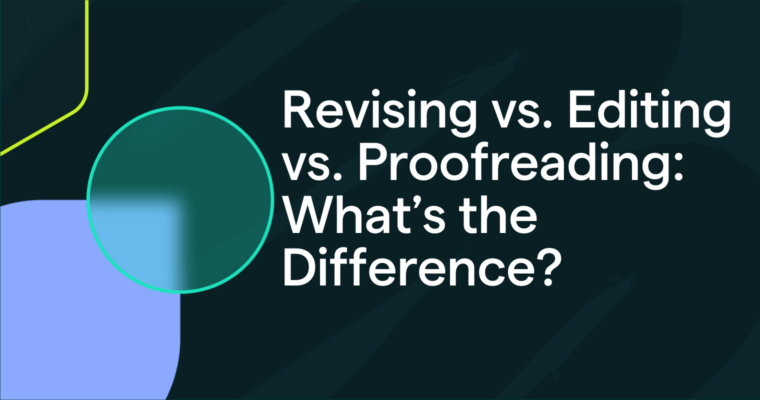
All types of writers benefit from prewriting—the process that prepares you to write—whether you’re a student who’s drafting a thesis paper or a professional screenwriter preparing for an upcoming project. Integrating this step into your writing process strengthens your writing by helping you develop and think through your ideas.
If you’re wondering why prewriting is important, consider Nobel Prize-winning author Toni Morrison’s famous quote:
“Writing is really a way of thinking—not just feeling but thinking about things that are disparate, unresolved, mysterious, problematic, or just sweet.”
Although prewriting takes additional time, it helps you explain your points articulately and coherently when you’re ready to write.
What is prewriting, and what is its purpose?
Prewriting typically happens before you buckle down to write the first draft. It’s a process that can be applied to any type of writing, such as a persuasive writing essay or a short story.
It’s a brainstorming activity that lets you define the purpose of your writing. The exercise encourages you to formulate your ideas, identify what you already know, and understand what you need to further explore to effectively make your point.
As a preliminary step in the overall writing process, it encourages you to think through your concepts so you avoid feeling stuck when you write. Prewriting can also help you determine a structure for your writing.
With continued practice, prewriting can help you write faster and more cohesively.
Prewriting vs. outlining
If the concept of prewriting sounds a lot like writing an outline, you aren’t wrong; outlining is technically one type of prewriting technique. However, outlining is generally more useful if you already have a grasp of your ideas and a plan for how you’ll approach your key points or arguments.
An outline typically includes a thesis and a bullet point structure of your ideas in the order you’ll write them in your paper. Under each topic or subtopic, you might include details about the main idea or additional analysis.
For this reason, some writers create an outline after fleshing out their ideas using other types of prewriting approaches. Some popular brainstorming techniques that you can try before outlining include “listing” and “clustering.”
How to prewrite: 5 additional prewriting techniques
If the prewriting step feels daunting, ask yourself the following questions as a starting point:
- What is the objective of this paper?
- What is my thesis? What argument or claim am I making?
- What assertions validate my thesis?
- Do I have supporting evidence for each point?
- How do I want to organize these points?
Being clear about your intentions ahead of time makes the prewriting process that much more productive. When you have a broad answer to these questions, you’re ready to apply your responses toward your preferred prewriting technique.
1 Clustering prewriting
Clustering is an effective prewriting strategy that helps you make connections between different ideas in a visual format. This technique is also called idea mapping; it gets this name because of the weblike visual effect that clustering creates on the page.
Here’s how it works:
- Write your primary idea in the middle of the page: Some writers circle or underline the idea. This might be your theme or thesis statement.
- Brainstorm secondary ideas: Other ideas related to your primary idea might come up in the brainstorming process. Write them around your central theme or idea, connecting the secondary ideas to your main idea.
- Repeat: Continue the above step for each secondary idea until all of your ideas are clustered in the idea map.
2 Freewriting prewriting
The freewriting prewriting technique is a timed activity (you decide the duration) where you write your thoughts in full sentences. The goal is to maintain focused writing about the topic without stopping during the allowed time. This means no editing for grammatical errors or spelling mistakes and no stopping when you feel unsure about your ideas.
When the time is up, read through what you wrote and identify the most compelling ideas. Repeat the process, focusing on the standout idea that you pulled from the first exercise to formulate a succinct and narrow focus for your writing project or assignment.
3 Looping prewriting
If developing a writing topic is challenging, looping can be a helpful prewriting technique. It builds on the freewriting technique by asking you to loop a handful of freewriting activities back-to-back. After your first looping exercise, find the key topic or idea in that writing, and use it as a jumping-off point for your next looping exercise.
By the end of five or so prewriting loops, you’ll have formed focused ideas that are closely related to a topic. These ideas can help you formulate a thesis statement or theme for your writing.
4 Listing prewriting
When you’re faced with a broad topic and don’t know how you want to focus your writing, creating a list may help. In a short time, typically five to ten minutes, write as many words and ideas as you can in a list format. Don’t worry about spelling or grammatical mistakes, and don’t overanalyze how you structure the idea.
Examine your list and place ideas in groups based on their relationship. For example, group together ideas or words that share a common theme. Write a sentence describing each grouped relationship. By this point, you’ve taken a broad topic and narrowed it down to a focused theme or idea with related words and ideas listed underneath it. Choose the most important or intriguing sentence to guide you through your writing.
5 Question-asking prewriting
Also referred to as “journalist’s questions,” the question-asking technique leverages the five Ws and one H that journalists strive to answer. On the page, you’ll answer the following question prompts, based on your central idea:
- Who?
- What?
- Where?
- When?
- Why?
- How?
Examples of prewriting
Below are a couple of examples of how the various prewriting strategies look in action. These examples use the topic “passion and generational trauma in Emily Brontë’s 1847 novel Wuthering Heights.”
Freewriting example
Time limit: 2 minutes
Love and revenge are two dynamic emotions that carry their own judgment. Love is conventionally perceived as a positive, joyful emotion, while revenge is considered adversarial and attributed to negative behavior. But the core sentiment underlying love and revenge is unbridled passion. Heathcliff’s strategically executed passion, whether in reaction to his undying love for Catherine or his zealous hatred of Hindley, doesn’t stop at lashing out at the key figures in his life. It seeps into the lives of the next generation at Thrushcross Grange, including Hareton Earnshaw, Cathy Linton, and Linton Heathcliff.
In this paragraph, we’ve identified the most compelling ideas to focus on in our writing assignment.
Question-asking example
- Who: Heathcliff, Catherine Earnshaw, Edgar Linton, Isabella Linton, Hindley Earnshaw
- What: Love and revenge are masqueraded as the other throughout the novel. The underlying sentiment that drives generational dissatisfaction and agony is passion.
- Where: Thrushcross Grange
- When: Hindley’s bullying and later attempted murder of Heathcliff as punishment for being Mr. Earnshaw’s favored child, love between Catherine and Heathcliff, Heathcliff seducing Isabella to spite Catherine’s marriage with Edgar.
- Why: Heathcliff’s passion, whether fueling love or revenge against figures in his life, results in generational trauma for Cathy Linton and Linton Heathcliff, who are forced to marry.
- How: Love is typically depicted as positive, while revenge is perceived negatively. Meanwhile, passion is more ambiguous yet is the most powerful driving force in Wuthering Heights and its characters.
Finding a prewriting strategy that complements your writing style is a matter of your own preference. If one prewriting technique doesn’t feel intuitive, try the next one on the list until you find an approach that works for you.
Prewriting FAQs
What is prewriting?
Prewriting is a preliminary step in the writing process. It’s an approach to brainstorming ideas that allows writers to connect their main points and highlights areas that need additional analysis or supporting evidence.
What is the purpose of prewriting?
Prewriting provides a clear writing path for ideas, from the beginning of an assignment to the end. It provides focus in writing by defining a purpose and letting writers clearly articulate their thoughts from one concept to the next. The result is a cohesive written work.
What are different ways to prewrite?
There are many different prewriting techniques. A few of the most popular types of prewriting include clustering, freewriting, listing, looping, and answering journalistic questions.






